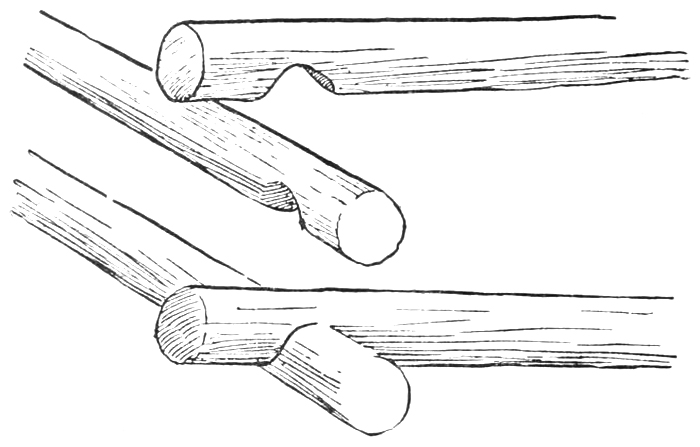This is the second installment in a series regarding the construction and outfitting of a wilderness camp from the book “Woodcraft” by E.H. Kreps, 1919. The instructions in this segment go over the initial construction of the cabin walls, floor, and placement of doors and windows. If you missed the first installment in the series, check that out also!
Wilderness Camp – part 2
On the spot chosen for the camp we now place two of the long logs, parallel with each other and exactly ten feet apart. We block them on the outside so they cannot be moved easily out of position. Then we place two of the short logs across the ends and in these we cut half-round notches directly over the places where they rest on the long logs, and almost half through each piece. After cutting these notches we turn the logs notched side down, and these cuts, if they have been properly done, fit snugly over the long logs, thus binding the four pieces together and forming the first round of the walls.

Before going farther now we must decide just where we are going to have the doorway of our cabin. We will place it on the south side, for we like to have the warm sun rays come in when the door is open, and if placed on the north or west sides it admits too much cold. We will place it near one end and then we can also put our window in the same side. About two or three feet from the corner we will cut out a section from the top of the log, making the cut four inches deep and two and a half feet wide, the bottom being hewn smooth and the ends sawed down square. Then we cut one of the balsam trees and saw a section from the butt the length of the proposed doorway. This should be not less than five feet, so we make it this length. Then we split through the centre with the axe and a pair of wooden wedges, and hew the two halves into two smooth planks. We also make a plank two and a half feet long. When these planks are finished we stand the two long ones upright in the place cut in the log and nail them firmly. We see that they stand perfectly plumb and in line with one another, then we nail the short plank across the top, thus completing our doorway. On this side, as the walls are laid up, we saw each log off squarely at the proper place and push it up against the door frame, fastening it there by nailing through the plank. The notches are cut to such a depth at the corners that the logs fit one against the other and this leaves no large cracks to close.
Find lots of unique solutions for your home, cabin or farmhouse at LEHMAN’S Old Time General Store! Shop now!
LOST WIT AND WISDOM IS A PROUD AFFILIATE OF LEHMAN’S
To make our cabin comfortable it must have a floor and we have this in mind as we work. Before building the wall higher we will lay our sills for the floor, for it is difficult to get these cut to the proper length and fitted in place after the walls are completed and the timber must be brought in through the doorway. We cut three straight logs about eight inches thick in the middle and 14 feet long. These are bedded into the ground in the cabin, one along each side wall and the other in the centre. They must be placed at an even height and this is determined by means of a straight ten-foot pole, which when placed across these logs should rest on each. If one of them is too high in spots we dress these places down with the axe.
We will now leave the floors and proceed with building the walls. Round by round the logs are notched and fitted into place, until the walls have reached a height of about four feet. Then we make a window boxing of planks and fasten it in the wall in the same way we did the door frame. The ends of the logs are butted against the window frame and fastened with large nails, driven through the planks into the logs. But before making the window frame the size of the proposed window must be determined, and this is done by measuring the width of the glass and making the proper allowance for the sash. When the logs are placed in the walls we try to select timbers of such a size that one round of logs will come within about three inches of the top of the window boxing, and the next log is cut out to fit down over this window and the frame is nailed fast to this log. The same thing is done when the top of the door frame is reached, and this gives a greater degree of rigidity to the walls.
In the next installment, the gables and roof of the wilderness camp will be constructed.
